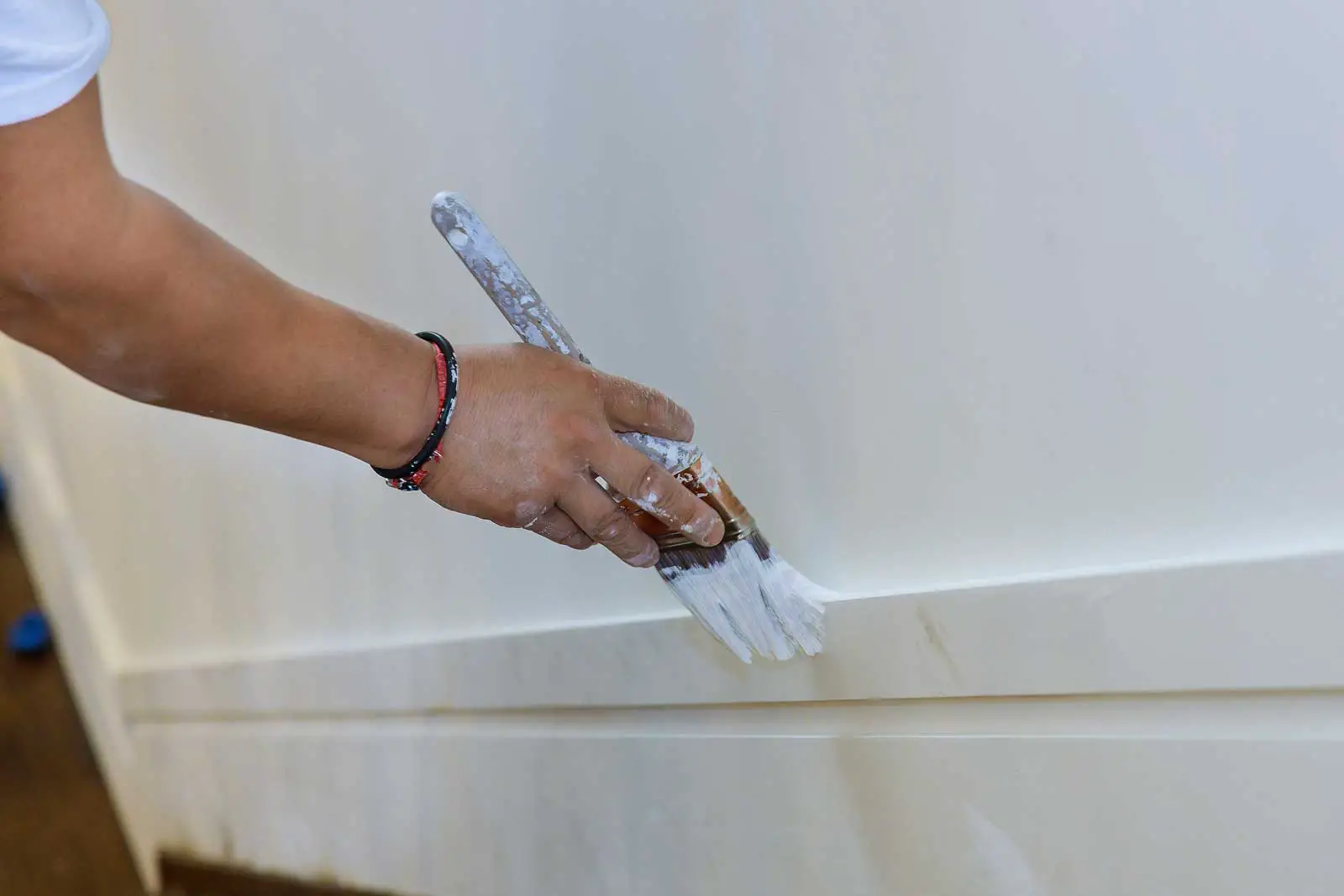Ever found yourself staring at a can of flat ceiling paint, wondering if it would work on your walls?
It’s tempting to use all that old paint in your garage, whether it’s for a base primer, or the actual finish. And it’s also tempting because ceiling paint is usually cheaper than paint you’d typically use for walls.
But before you open up that paint can and start rolling it on, there are some things you need to think about.
So can you really use ceiling paint on your walls?
Yes, you can technically use ceiling paint on walls, but it’s not typically recommended. Ceiling paint is generally formulated with a flat finish to hide imperfections, and may not provide the durability or washability that wall paint does. It’s usually best to use paint specifically designed for walls to ensure longevity and easy maintenance.
However, if you use ceiling paint on walls you may look at the finished product and be less than thrilled with the results.
In this article, we’ll explore the pros and cons of using ceiling paint on walls and offer some tips for choosing the right paint for your project.
By the way – before we get too far along here, if you want to connect with other homeowners, DIYers, and builders and get more great ideas for your home to make your space the best join my free private Facebook group, Remodel Reality here.
 Understanding Ceiling Paint
Understanding Ceiling Paint
When it comes to painting your walls, you may wonder if you can use ceiling paint instead of regular wall paint. To answer this question, it’s important to understand what ceiling paint is and how it differs from regular wall paint.
Definition of Ceiling Paint
Ceiling paint is a type of paint specifically designed for use on ceilings. It is typically a flat or matte finish, which helps to hide imperfections and reflects less light. This can make a room feel cozier and more intimate. Ceiling paint is also often formulated to be drip-resistant, which can be helpful when painting overhead.
Differences Between Ceiling Paint and Regular Wall Paint
While ceiling paint and regular wall paint may look similar, they are formulated differently. Regular wall paint is designed to be applied to vertical surfaces and is available in a range of finishes, including flat, eggshell, satin, semi-gloss, and high-gloss. In contrast, ceiling paint is formulated to be applied to horizontal surfaces and is typically only available in a flat or matte finish.
Properties and Benefits of Ceiling Paint
One of the main benefits of using ceiling paint on walls is that it is often less expensive than regular wall paint. Additionally, ceiling paint is designed to be drip-resistant, which can be helpful when painting overhead. However, there are also some downsides to using ceiling paint on walls. For example, ceiling paint is often more difficult to clean than regular wall paint, and it may not offer the same level of durability or aesthetic appeal.
So, can you use ceiling paint on walls? The answer is yes, but it may not always be the best choice. It’s important to consider the differences between ceiling paint and regular wall paint, as well as the properties and benefits of each, before making a decision.
Now that you have a better understanding of what ceiling paint is, let’s take a closer look at the benefits and drawbacks of using it on your walls.
 Using Ceiling Paint on Walls
Using Ceiling Paint on Walls
If you’re looking to update the look of your interior walls, you may be wondering if you can use ceiling paint on walls. Let’s explore the possibilities, advantages, and disadvantages of using ceiling paint on walls, as well as factors to consider when making your decision and other types of paint that can be used on walls.
Exploring Whether Ceiling Paint Can Be Used on Interior Walls
It is possible to use ceiling paint on walls, but it’s important to keep in mind that ceiling and wall paint are designed for different surfaces. Ceiling paint is typically thinner than wall paint, which means it can be used on walls, but it must be thinned even further before application. On the other hand, wall paint is thicker and is not recommended for use on ceilings unless it is thinned to prevent drips.
Advantages and Disadvantages of Using Ceiling Paint on Walls
There are both advantages and disadvantages to using ceiling paint on walls. One advantage is that ceiling paint is typically cheaper than wall paint, which can save you money.
Additionally, ceiling paint can prevent drips and provide a flat finish. However, ceiling paint is difficult to clean and does not offer the same aesthetics as wall paint. It’s also important to note that using ceiling paint on walls may limit your color options.
Factors to Consider When Deciding Whether to Use Ceiling Paint on Walls
When deciding whether to use ceiling paint on walls, there are several factors to consider. First, consider the type of room you’re painting. If it’s a high-traffic area, you may want to use a more durable wall paint. Additionally, think about the color you want to use.
If you’re limited in color options with ceiling paint, you may want to consider using wall paint instead. Finally, consider the finish you want to achieve. Ceiling paint provides a flat finish, while wall paint can provide a variety of finishes, such as matte, eggshell, satin, and gloss.
Other Types of Paint That Can Be Used on Walls
If you decide not to use ceiling paint on walls, there are several other types of paint that can be used. For example, latex paint is a popular choice because it is easy to clean and durable.
Oil-based paint is another option, but it can be more difficult to clean up and has a longer drying time. Additionally, there are specialty paints, such as chalk paint and metallic paint, that can add unique finishes to your walls.
In conclusion, while it is possible to use ceiling paint on walls, it’s important to consider the advantages and disadvantages, as well as other factors, before making your decision. Ultimately, the type of paint you choose will depend on your personal preferences and the specific needs of your project.
 Using Wall Paint on Ceilings
Using Wall Paint on Ceilings
When it comes to painting your home, you might wonder if you can use wall paint on your ceilings. In this section, we will discuss whether it’s possible to use wall paint on ceilings, the advantages and disadvantages of doing so, and factors to consider when deciding whether to use wall paint on ceilings.
Discussion on Whether It’s Possible to Use Wall Paint on Ceilings
The short answer is yes, you can use wall paint on your ceilings. However, it’s important to note that wall paint is thinner than ceiling paint, which means it might not cover as well and could drip more easily. Additionally, if your ceiling is heavily textured, wall paint might not adhere as well as ceiling paint.
Advantages and Disadvantages of Using Wall Paint on Ceilings
The advantage of using wall paint on your ceilings is that you have more color options available to you. Wall paint comes in a wider variety of colors and finishes than ceiling paint. Additionally, if you’re looking to save money, wall paint is typically less expensive than ceiling paint.
However, there are also some disadvantages to using wall paint on your ceilings. As mentioned earlier, wall paint is thinner than ceiling paint, which means it might not cover as well and could drip more easily. Additionally, if your ceiling is heavily textured, wall paint might not adhere as well as ceiling paint. Lastly, if you ever need to touch up your ceiling, it might be difficult to find the exact shade of wall paint you used.
Factors to Consider When Deciding Whether to Use Wall Paint on Ceilings
Before deciding whether to use wall paint on your ceilings, there are a few factors you should consider. First, consider the texture of your ceiling. If your ceiling is heavily textured, ceiling paint might be a better option. Second, consider the color you want to use. If you’re looking for a specific color that isn’t available in ceiling paint, wall paint might be your best bet. Lastly, consider your budget. If you’re looking to save money, wall paint is typically less expensive than ceiling paint.
Overall, using wall paint on your ceilings is possible, but it’s important to consider the advantages and disadvantages before making a decision. Factors such as the texture of your ceiling, the color you want to use, and your budget should all be taken into account.
Types of Paint Finishes
From the understated elegance of flat finish to the resilient luster of semi-gloss, each type of finish brings a unique character and practicality to your walls and ceilings.
Explanation of Different Types of Paint Finishes
When it comes to painting walls and ceilings, there are three main types of paint finishes to choose from: flat, eggshell, and semi-gloss. Flat paint has a matte finish, which means it doesn’t reflect light and has a smooth, velvety texture. Eggshell paint has a slight sheen and is more durable than flat paint, making it easier to clean. Semi-gloss paint has a shiny finish and is the most durable of the three.
Advantages and Disadvantages of Each Type of Paint Finish
Each type of paint finish has its own set of advantages and disadvantages. Flat paint is great for hiding imperfections on walls, but it is not very durable and can be difficult to clean. Eggshell paint is more durable than flat paint and has a slight sheen, but it can also be difficult to clean. Semi-gloss paint is the most durable of the three and is easy to clean, but it can highlight imperfections on walls and ceilings.
Best Types of Paint Finishes for Ceilings and Walls
When it comes to painting ceilings, flat paint is the best option because it doesn’t reflect light and hides imperfections well.
For walls, eggshell or semi-gloss paint are good options because they are more durable and easier to clean than flat paint.
However, it’s important to consider the condition of the walls and the amount of traffic the room sees before deciding on a paint finish.
There are three main types of paint finishes to choose from when painting walls and ceilings: flat, eggshell, and semi-gloss. Each type has its own set of advantages and disadvantages, and the best type of paint finish for a particular surface depends on the condition of the surface and the amount of traffic the room sees.
Choosing the Right Paint
Choosing the right paint for your painting project is essential to achieve the desired results. Here are some tips to help you select the right paint:
Tips for Selecting the Right Paint for Your Painting Project
- Consider the surface you will be painting. Different surfaces require different types of paint.
- Think about the color you want to achieve. You can select from a wide range of colors, but you should consider the color scheme of the room or area you will be painting.
- Consider the viscosity of the paint. The viscosity of the paint will affect how easy it is to apply and how well it will cover the surface.
- Think about the humidity level in the area you will be painting. High humidity can affect how well the paint will dry and how long it will take to dry.
Factors to Consider When Selecting Paint
When selecting paint, there are several factors you should consider:
- Color
- Viscosity
- Drying time
- Odor
- Cleanability
Each of these factors can affect the final outcome of your painting project, so it’s important to consider them carefully.
Best Places to Purchase Paint
When it comes to purchasing paint, you have several options:
- Local paint shops
- Home improvement stores
Both options offer a wide selection of paint colors and types, as well as knowledgeable staff who can help you select the right paint for your project. Additionally, many home improvement stores offer online ordering and delivery, making it easy to get the paint you need without leaving your home.
Remember, selecting the right paint is essential to achieving the desired results for your painting project. Take the time to consider the factors and options available to you, and don’t be afraid to ask for help if you need it.
Painting Techniques and Tips
When it comes to painting, there are a few techniques and tips that can help you achieve a professional-looking finish. In this section, we’ll cover the tools you’ll need, techniques for achieving a uniform finish and avoiding lap marks, and tips for painting high-traffic areas and ceilings with light fixtures.
Tools Needed for Painting
Before you start painting, you’ll need to gather the right tools. Here are the essentials:
- Paint rollers and trays
- Paintbrushes
- Painter’s tape
- Dropsheets or plastic sheeting to protect floors and furniture
- Sandpaper and spackle for prepping walls
Techniques for Achieving a Uniform Finish and Avoiding Lap Marks
One of the biggest challenges when painting walls and ceilings is achieving a uniform finish and avoiding lap marks. Here are some tips:
- Start by cutting in the edges and corners with a paintbrush before using a roller.
- Work in sections, rolling the paint in a “W” or “V” shape to avoid lap marks.
- Roll in one direction, and then go back over the same section in the opposite direction to create a smooth finish.
- Avoid overloading the roller with paint, as this can lead to drips and uneven coverage.
Tips for Painting High-Traffic Areas and Ceilings with Light Fixtures
Painting high-traffic areas and ceilings with light fixtures can be tricky. Here are some tips:
- Use a durable paint that can withstand wear and tear.
- Remove light fixtures or cover them with plastic sheeting to protect them from paint splatters.
- When painting a ceiling, start in the middle of the room and work your way outwards.
- Use a paintbrush to cut in around the edges of the ceiling before using a roller.
Remember, painting takes practice, so don’t be too hard on yourself if you don’t get it right the first time. With these techniques and tips, you’ll be well on your way to achieving a professional-looking finish.
Related and Frequently Asked Questions
Q: Can I use ceiling paint as a primer on walls?
A: Ceiling paint can be used as a primer on walls, but it’s not typically the best choice. A high-quality primer, specifically designed for wall surfaces, will provide better coverage and create a smoother finish for the top coat. If you decide to use ceiling paint as a primer, be sure to apply it in small sections using a paint roller for the best results.
Q: Can you use ceiling paint on exterior walls?
A: No, ceiling paint is not recommended for exterior walls. It is designed for interior use and may not withstand outdoor conditions well. Exterior paints are specifically formulated to resist weathering, UV damage, and mildew stains. It’s always a good idea to consult with a professional at your local paint shop to ensure you’re using the right kind of paint for your project.
Q: Can ceiling paint be used on bathroom walls?
A: While you can use ceiling paint on bathroom walls, it may not be the best choice due to the high humidity and potential for mildew in bathrooms. Bathroom walls usually do better with a semi-gloss or high-gloss paint that can resist moisture better. If you prefer a flat appearance, consider using a paint specifically designed for bathrooms that combines the flat look with better moisture resistance.
Q: Does it matter if you use ceiling paint?
A: Yes, it does matter. Ceiling paint is formulated differently than typical wall paint. It’s usually a flat white paint that helps to reflect light and hide imperfections, which can enhance the lighter color of the ceiling and make the entire room look more spacious. Its higher viscosity helps to prevent drips when painting overhead.
Q: What is the difference between primer and ceiling paint?
A: Primer and ceiling paint serve different purposes. Primer is designed to prepare the wall surface for a fresh coat of paint, ensuring better adhesion and helping to mask darker colors. On the other hand, ceiling paint is specifically formulated to create a flat, light-reflective surface and to resist dripping when applied to a ceiling.
Q: What is the difference between ceiling paint and regular wall paint?
A: The main difference between ceiling paint and regular wall paint lies in their formulation and purpose. Ceiling paint is designed for use on ceilings and is typically a flat white or light color. It has a high viscosity to prevent drips when painting overhead. Wall paint is designed for vertical surfaces and comes in a range of finishes including flat, eggshell, satin, semi-gloss, and high-gloss.
Q: Can I use Dulux ceiling paint on walls?
A: While you can technically use Dulux ceiling paint on walls, it may not provide the best finish or durability due to its formulation. For best results, it’s recommended to use paint that is specifically designed for walls.
Q: What paint should not be used in bathrooms?
A: Flat or matte finishes should generally not be used in bathrooms due to their inability to withstand high levels of moisture. Instead, semi-gloss or high-gloss paints are recommended for their water-resistant properties.
Q: Can ceiling paint be used on doors?
A: It’s generally not recommended to use ceiling paint on doors. Doors often require a more durable, easy-to-clean paint due to high-traffic use. Semi-gloss or high-gloss paints are usually a good choice for doors.
Next Steps
Want to join others who are creating the most amazing home redesigns & renovations and get more tips, tricks and hacks on how to make your home the best it can be?
Join my brand new free private Facebook group, Remodel Reality to connect with other people like you to make your space the best!






